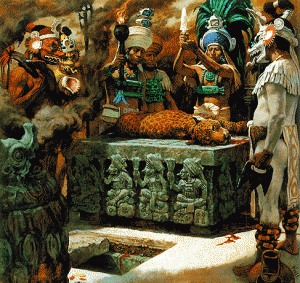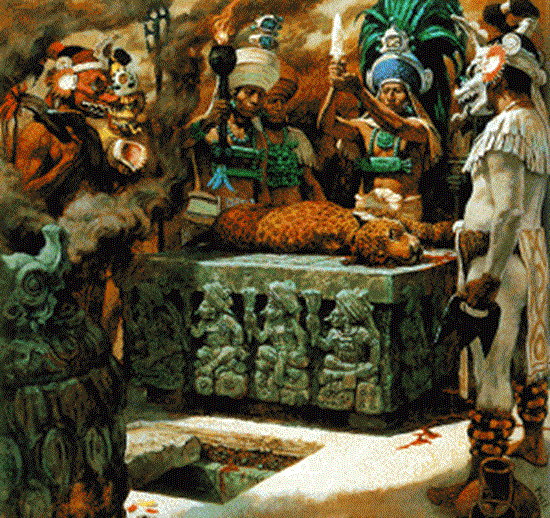
Let’s humor the doomsday prophets: what if the art world ends in 2012?
The web has been rife with Mayan predictions of a 2012 doomsday on Dec. 21. This date was discovered on a stele carving at a little known archaeological site in Tabasco, Mexico, and it points to the day that the gods of the underworld will rise up to destroy the world as we know it. These dire predictions have already been discredited by several Mayan scholars, but people love to believe in false prophecies, and the apocalyptic story has garnered interest from all sorts of quacks, even prompting the scientists on NASA’s website to comment: “There is no credible evidence for any of the assertions made in support of unusual events taking place in December 2012.”
But what if those prophets were right? What if the world really does end? How would we in the art world choose to handle this scenario?
At first blush one would think that with our impending doom only 11 months away, it would be time to really “go for it,” to do everything we always wanted to do but didn’t dare; but what would that even mean? Would there be crazy spending, insane orgies, wild excess of every kind? Why can’t it mean the exact opposite? Why can’t the end be a new beginning where art dollars would be spent on works that broaden our understanding, that expand our inner universe? Perhaps with the end in sight people would find the courage to give up the current obsession with trophy hunting and status art and instead define their own tastes. They would cast aside the endless need for consensus, that lemming effect that rules art today.
As for galleries, would they continue to get artists to produce all they can sell, and even quite a bit more, or would they scale back and do only shows they really believe in? Would the super-successful artists keep “pumping it out,” producing any and all work that they felt like doing, without any consideration for self-editing? How about the art critics? Would they now dare to champion artists and shows that weren’t part of the consensus? Would the Chinese wall between church (art) and state (market) collapse so that art could be openly discussed in terms of both its cultural value and its commercial value?
But reflecting on the end of the art world doesn’t have to be a descent into nihilistic anarchy, filled with irresponsible mudslinging and backstabbing: the product of the fragile, bloated egos of some and the pure greed of others. Even in the absence of the threat of the end of the world, we need to think about a better art world for those who love art, and for the benefit of everyone concerned. Today the stage is set for positive change, with more galleries, more collectors and more opportunities for great art than ever before. But how do we get there from here?
Last weekend I attended a lecture and meditation given by Buddhist scholar Robert Thurman at his upstate Menla mountain retreat. The meditation, a seven-part path to enlightenment from the great eighth-century Indian monk Shantideva, led me to reflect on a better and more fulfilling 2012 because, Armageddon or not, we all want that which fulfills and improves us. It begins with the understanding that everything is interconnected, that every action has a consequence. Meditating on these steps can bring us closer to art enlightenment, even if we never get all the way there in this life.
1. Open your mind to beginningless-ness, by giving up, if only for a moment, your own beginning to see that everything and everyone has made you what you are: everyone is your mother. For us that means every work of art, every artist, every critic, every curator, good or bad, is art’s mother. They all make art what it is today, so we find love for them all and recognize them as our mother.
2. Meditate on the kindness of our mother, the nurturing beauty of our mother (not your real mother, who never seemed to have loved you), and recognize the whole art world as our mother.
3. Consciously decide to repay your mother. In the art world, that would mean helping a curator with his or her next show, or supporting an artist’s work because he or she needs it. Why not help that struggling gallery make it, or put up some money to get that catalog published and even humor that nauseating, self-righteous art critic? Make them all feel good, because it’s in the best interest of our mother.
4. Focus on the beauty in all these people. Think of their good, ignore their competitiveness, their jealousies, their greed, their self-promoting egos, their double standards, their hypocrisies, because we love them all as we do our idealized mother.
5. Here comes the compassion: help them all. Whether they are good or bad no longer matters, because they are us, and so we feel for them and with them; we want to help them. We’ve given up our distinctions of rich and poor, smart and dumb, good art and bad; we feel compassion for all of it and all of them.
6. By taking responsibility for them, we can treat them with real consideration, because we want to help them, not just take from them. So we give to all of them, not equally, but in the amount they need. This giving is not only money, it’s time and thought and love.
7. Try to turn the heart inside out. This is the hardest part. Even if you can’t do it, imagine that you can, even for a moment. We now attempt to embrace our inner connectedness to the art world and we realize that to help it is to help ourselves. To make this our best art year ever, we must help all others as much as we can.
According to Shantideva, the source of real happiness is wishing happiness unto others, and the source of all unhappiness is seeking happiness for ourselves. In my own art world practice, I’ve done some of the former and much of the latter, but in this year in which the Mayans predicted the end of the world will take place, let’s all move on and find our art world age of Aquarius. I will find love for those who disagree with and even disrespect me, no matter how wrong, or how crude they may be. I will meditate on “art love” for all, not for their benefit but for my own.
